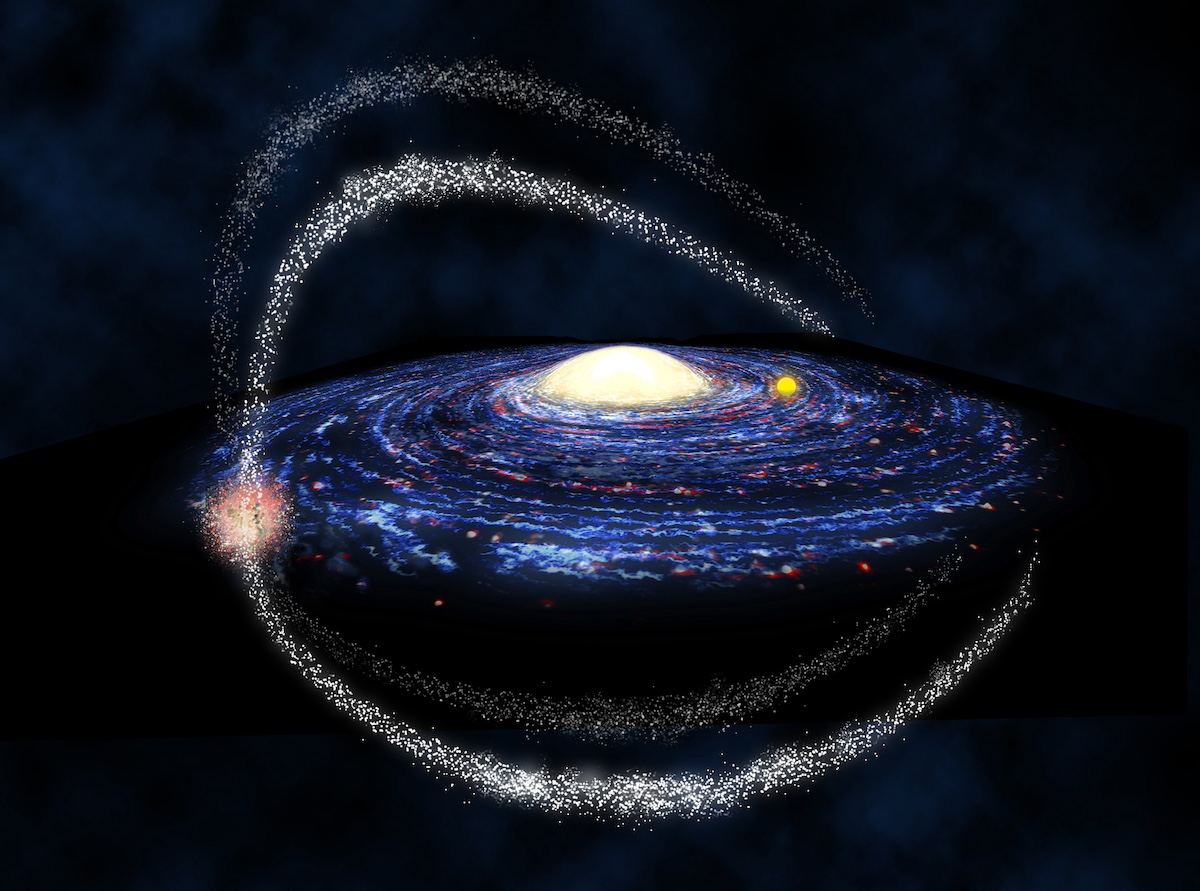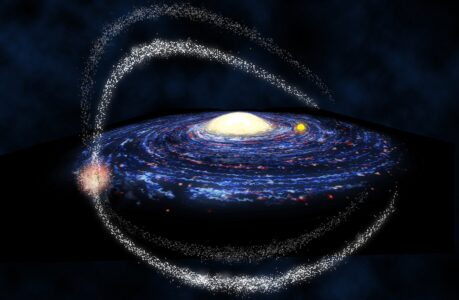Unveiling the Mysteries of Our Cosmic Neighbor
In the vast expanse of the cosmos, where countless galaxies twinkle like distant stars, lies one of the most enigmatic and intriguing objects of our universe—the Canis Major Dwarf Galaxy. Just 25,000 light-years away from our Milky Way, this diminutive galaxy packs a punch in terms of cosmic significance. Join us on a journey through space and time as we delve deep into the heart of the Canis Major Dwarf Galaxy, exploring its origins, structure, and the profound impact it has on our understanding of the universe.
Unveiling a Cosmic Neighbor
A Galactic Odyssey Begins
The Canis Major Dwarf Galaxy, often referred to as the “CMa Dwarf,” was first discovered in 2003 by astronomers utilizing data from the Two-Micron All-Sky Survey (2MASS). This unassuming cosmic neighbor was hiding in plain sight, concealed by the brilliance of the Milky Way, which it orbits as a satellite galaxy. Despite its modest size, the CMa Dwarf has captured the imagination of scientists and stargazers alike.
What’s in a Name?
The name “Canis Major Dwarf Galaxy” may sound like a mouthful, but it is derived from its location in the constellation Canis Major, which means “Greater Dog” in Latin. This celestial connection adds a layer of mystique to an already fascinating object in our night sky.
A Miniature Marvel
Diminutive Dimensions
The Canis Major Dwarf Galaxy is not your typical spiral or elliptical galaxy; instead, it is classified as an irregular dwarf galaxy. This classification results from its irregular shape and smaller size compared to the Milky Way. The CMa Dwarf measures a mere 42,000 light-years in diameter, which pales in comparison to the Milky Way’s sprawling 100,000 light-year expanse.
The Stellar Composition
One of the most remarkable aspects of the Canis Major Dwarf Galaxy is its unique stellar population. While the Milky Way boasts billions of stars, the CMa Dwarf contains only a fraction of that number. Estimates suggest that it is home to around one billion stars, making it a cosmic lightweight by comparison. However, within this diminutive galaxy, stars have some intriguing stories to tell.
Galactic Tango
As the Canis Major Dwarf Galaxy orbits our Milky Way, it engages in a cosmic dance that shapes its structure and destiny. The gravitational interactions between the two galaxies cause ripples and distortions in the CMa Dwarf’s form, creating intricate patterns of stars and gas that astronomers continue to study with fascination.
An Enigmatic History
A Galactic Collision
The Canis Major Dwarf Galaxy holds a secret hidden deep within its stellar population—a turbulent history. It is widely believed that this cosmic wanderer was once a much larger galaxy before a fateful encounter with the Milky Way. The gravitational forces unleashed during this collision altered the CMa Dwarf’s shape and set it on a path of transformation.
Ancient Stars
One of the most astonishing revelations about the Canis Major Dwarf Galaxy is the age of its stars. While the Milky Way boasts a wide range of star ages, from billions of years old to newly formed, the CMa Dwarf predominantly consists of ancient stars. These stellar relics provide a glimpse into the early stages of our universe, shedding light on its formation and evolution.
Cosmic Archeology
Astronomers are akin to cosmic archaeologists when they study the Canis Major Dwarf Galaxy. By examining the chemical composition and properties of the stars within this dwarf galaxy, they can piece together a timeline of its tumultuous history and its role in shaping the Milky Way we know today.
Cosmic Conundrums
The Dark Matter Enigma
The Canis Major Dwarf Galaxy is not just a treasure trove of historical insights but also a source of perplexing cosmic mysteries. Among the most confounding questions is the nature of dark matter within this galaxy. Dark matter is an invisible, enigmatic substance that makes up a significant portion of the universe’s mass. Observations of the CMa Dwarf suggest that it may contain an unusually high concentration of dark matter, challenging our current understanding of its distribution in galaxies.
The Great Escape
Another cosmic conundrum associated with the Canis Major Dwarf Galaxy is its eventual fate. Will it continue to orbit the Milky Way indefinitely, or will it eventually break free and drift into the cosmic void? This question has fueled many debates among astronomers and adds an element of uncertainty to the galaxy’s future.
Observing the CMa Dwarf
The Astronomical Tools
Studying a galaxy 25,000 light-years away is no small feat. Astronomers employ a variety of cutting-edge tools and techniques to unravel the mysteries of the Canis Major Dwarf Galaxy. From ground-based observatories to space telescopes like the Hubble Space Telescope, these instruments provide a glimpse into the galaxy’s secrets.
Star Clusters and Nebulae
Within the Canis Major Dwarf Galaxy, there are numerous star clusters and nebulae waiting to be explored. These celestial formations offer insight into the formation and evolution of stars, providing a window into the past and present of this remarkable cosmic neighbor.
Cosmic Peering
One of the most captivating aspects of studying the Canis Major Dwarf Galaxy is that it provides a unique perspective on our own Milky Way. By examining the interactions between these two galaxies, astronomers gain valuable insights into the dynamics of galactic systems, shedding light on the broader processes that shape the universe.
The Impact on Our Understanding
Expanding Our Cosmic Horizon
The Canis Major Dwarf Galaxy may be small in size, but its significance looms large in the field of astrophysics. By studying this diminutive galaxy, scientists expand their understanding of the universe’s vast tapestry, offering new insights into the formation and evolution of galaxies, the nature of dark matter, and the intricate interplay between cosmic neighbors.
Lessons from the Stars
The ancient stars within the CMa Dwarf serve as cosmic time capsules, allowing astronomers to peer back in time and witness the universe’s early epochs. These stars tell stories of the past, providing clues about the conditions that prevailed during the universe’s infancy.
A Constantly Evolving Mystery
As technology advances and our understanding of the cosmos deepens, the Canis Major Dwarf Galaxy remains an ever-evolving mystery. New discoveries and revelations continue to reshape our perception of this celestial neighbor, reinforcing the idea that there is always more to learn about the universe.
Canis Major Dwarf Galaxy
The Ongoing Quest
The study of the Canis Major Dwarf Galaxy is not just a scientific endeavor; it is a testament to humanity’s insatiable curiosity and unrelenting quest for knowledge. In the vastness of space, there are countless mysteries waiting to be unraveled, and the CMa Dwarf is just one chapter in our ongoing cosmic odyssey.
The Cosmos Beckons
As we conclude our journey through the Canis Major Dwarf Galaxy, we are reminded that the universe is a boundless expanse of wonder and awe. Its mysteries beckon us to explore, to question, and to discover, fueling our collective fascination with the cosmos and inspiring generations to come.
Explore more cosmic wonders:
- Hubble Space Telescope – Discover the latest images and findings from the Hubble Space Telescope.
- Two-Micron All-Sky Survey (2MASS) – Learn about the 2MASS project, which played a pivotal role in the discovery of the Canis Major Dwarf Galaxy.
- Dark Matter – Dive deeper into the enigma of dark matter and its role in the universe.
In our cosmic quest, we find not only answers but also new questions, pushing the boundaries of our knowledge and imagination. The Canis Major Dwarf Galaxy is a testament to the wonders that await us in the endless expanse of the universe, and it reminds us that the journey of discovery is an unending odyssey, forever calling us to explore the cosmic horizon.

